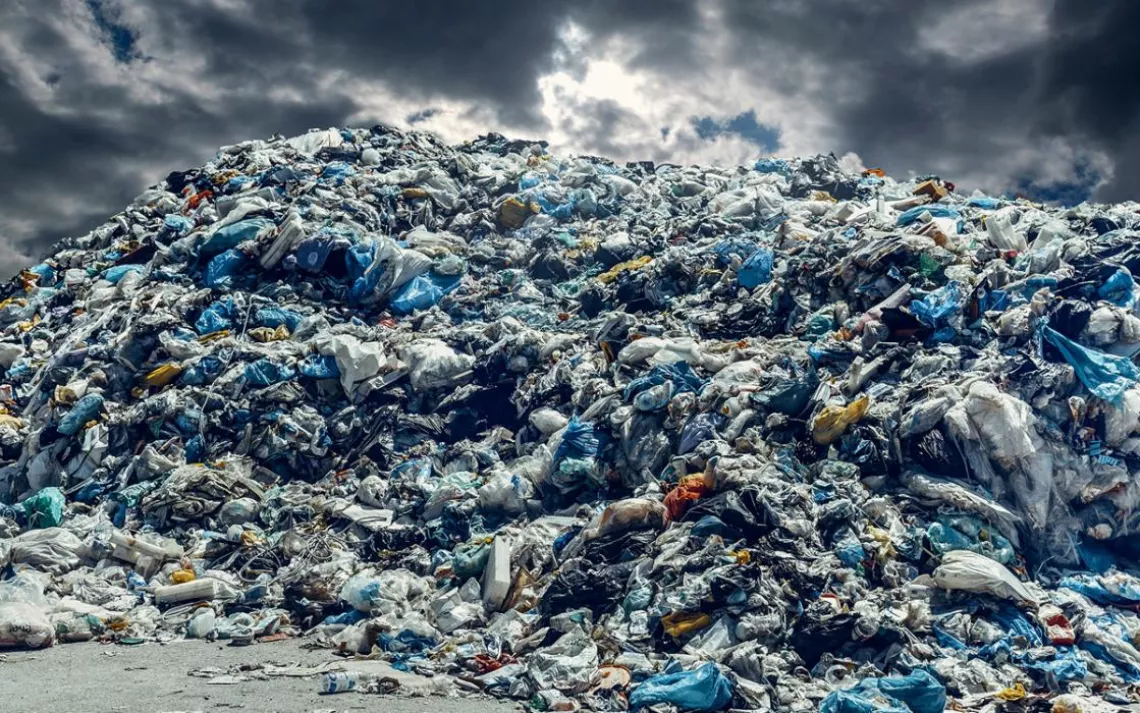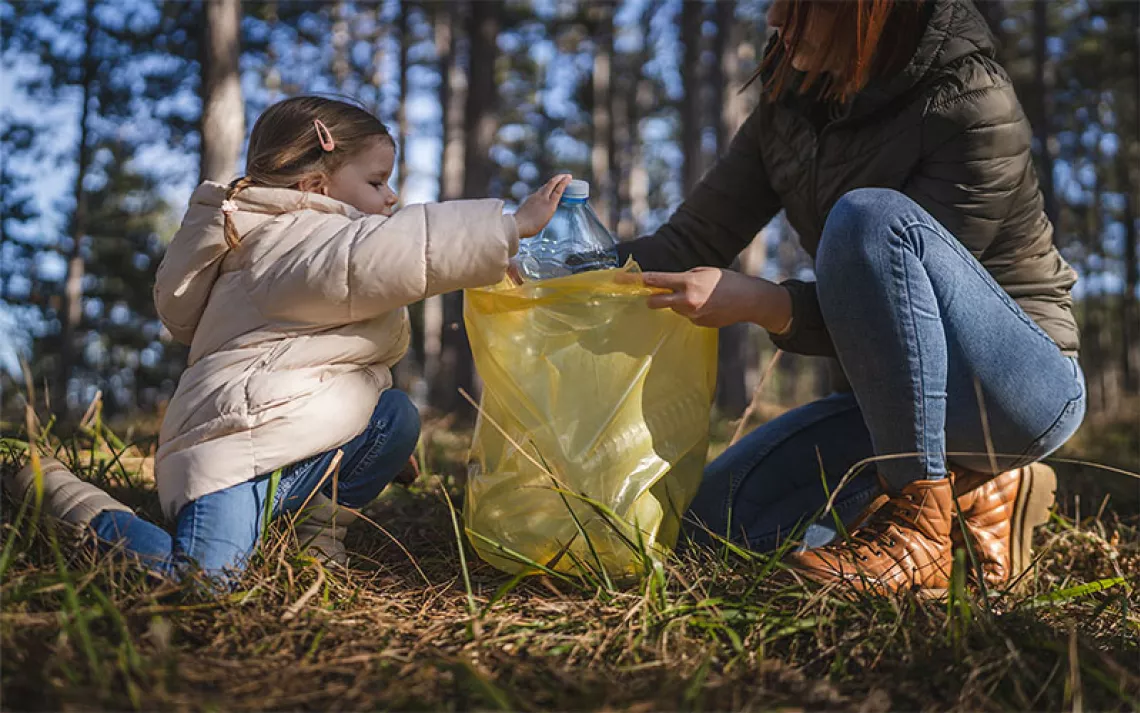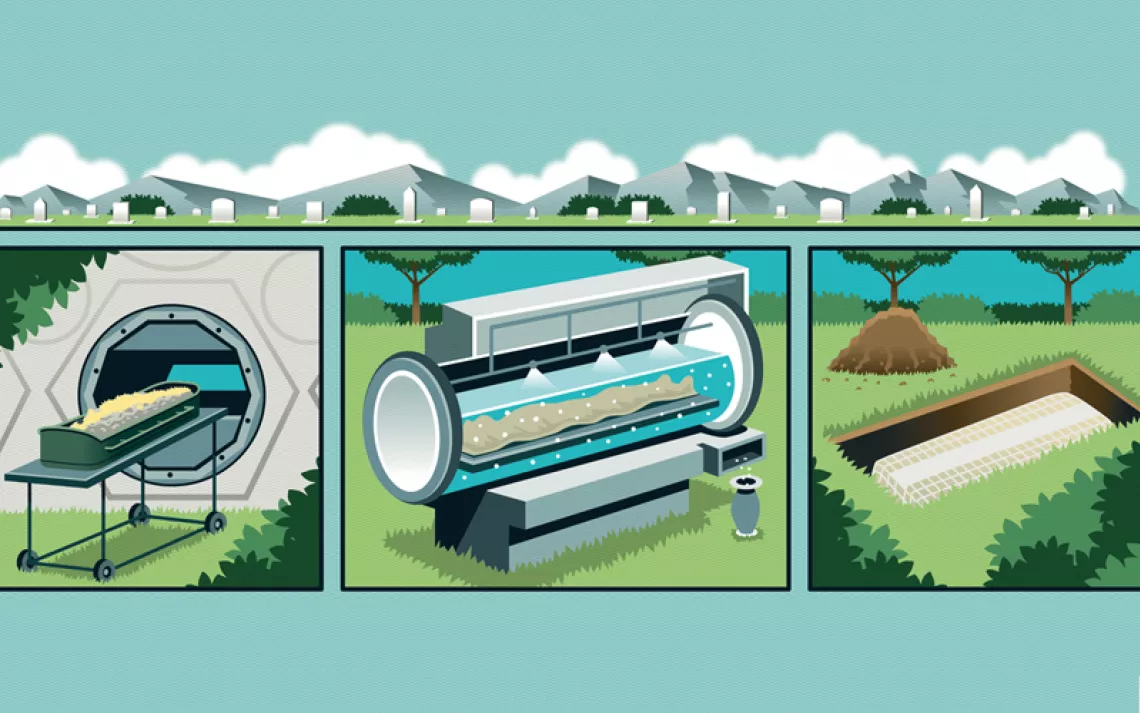The US Recycling System Is Garbage
China doesn't want our crap anymore, and who can blame them?

China has shut down its inefficient, polluting "recycling villages" in favor of modern facilities. | Photo-illustration by D-Keine/Getty Images
FOR NEARLY THREE DECADES your recycling bin contained a dirty secret: Half the plastic and much of the paper you put into it did not go to your local recycling center. Instead, it was stuffed onto giant container ships and sold to China.
Around 1992, US cities and trash companies started offshoring their most contaminated, least valuable "recyclables" to a China that was desperate for raw materials. There, the dirty bales of mixed paper and plastic were processed under the laxest of environmental controls. Much of it was simply dumped, washing down rivers to feed the crisis of ocean plastic pollution. Meanwhile, America's once-robust capability to sort, clean, and recycle its own waste deteriorated. Why invest in expensive technology and labor when the mess could easily be bundled off to China?
Then in 2018, as part of a domestic crackdown on pollution, China banned imports of dirty foreign garbage. In the United States, the move was depicted almost as an act of aggression. (It didn't help that the Chinese name for the crackdown translated as National Sword.) Massive amounts of poor-quality recyclables began piling up at US ports and warehouses. Cities and towns started hiking trash-collection fees or curtailing recycling programs, and headlines asserted the "death of recycling" and a "recycling crisis."
But a funny thing happened on recycling's road to the graveyard. China's decision to stop serving as the world's trash compactor forced a long-overdue day of reckoning—and sparked a movement to fix a dysfunctional industry. "The whole crisis narrative has been wrong," says Steve Alexander, president of the Association of Plastic Recyclers. "China didn't break recycling. It has given us the opportunity to begin investing in the infrastructure we need in order to do it better."

Plastic bottles are sorted in China. | Photo by China Photos/Getty Images
"That's the silver lining in National Sword," adds David Allaway, a senior policy analyst for Oregon's Department of Environmental Quality and the coauthor of a surprising new study that demonstrates the ecological downsides of pursuing recycling at any cost (see "When Recycling Isn't Worth It"). "China finally is doing the responsible thing, forcing the recycling industry to rebuild its ability to sort properly and to focus on quality as much as it previously focused on quantity."
Paradoxically, Allaway says, part of America's trash problem arose from people trying to recycle too much. Well-meaning "aspirational" recyclers routinely confuse theoretical recyclability with actual recycling. While plastic straws, grocery bags, eating utensils, yogurt containers, and takeout food clamshells are all theoretically recyclable, they are almost never recycled. Instead, they jam machinery and lower the value of the profitably recyclable materials they are mixed with, like aluminum cans and clean paper. In addition, Americans are notorious for putting pretty much anything into recycling bins, from dirty diapers to lawn furniture, partly out of ignorance and partly because China gave us a decades-long pass on making distinctions.
"We need to recycle better and recycle smarter," Allaway says, "which means recycling only when the positive environmental impacts outweigh the negative."
MARTIN BOURQUE is the executive director of the Ecology Center, the nonprofit that handles curbside recycling for Berkeley, California. During the early days of recycling, in the 1970s and '80s, he says, US consumers routinely cleaned their recyclables of food residues and separated materials. Berkeley residents originally sorted recyclables into seven categories, including by color of glass.
That system changed in the 1990s, when a rapidly industrializing China started to aggressively import mixed paper and plastics from western countries to get feedstock for the products that it was manufacturing and exporting back to those same countries. This coincided with a consolidation of the US trash business into the current dominance of a few large corporations, which were happy to let China do all the work. US trash collectors and recycling facilities found that they could elevate quantity above quality and make more than $20 a ton doing so.
Offshoring cut labor and transportation costs and reduced the need to update sorting and cleaning machinery. Cities and waste companies abandoned methodical curbside sorting in favor of the far cheaper and now predominant single-stream method, in which all recyclables go into one bin that's picked up by one trash truck. Only minimal sorting by the collectors was required, as different kinds of plastic (including types that can't be recycled) could be packaged into giant, stinky bales. People felt virtuous throwing most everything into the recycling bin—never suspecting that the system was guaranteed to contaminate and render useless much of it.

A redemption center in Brooklyn, New York. Bottle bills like the one in New York boost recycling rates and provide needed income to homeless and other marginalized people. | Photo by Spencer Platt/Getty Images
Mixed paper could be bundled in the same way, much of it contaminated from mingling in the bin with dirty dog food cans and worse. These bales would be taken to the nearest port and loaded onto container ships bound for China—4,000 containers a day prior to 2018. Other countries did the same, and by 2016, China was importing more than half of the world's plastic and paper trash.
As much as 30 percent of those single-stream recyclables was contaminated by nonrecyclable materials, Bourque says. Many of the bales of plastic sent to China were worthless and were never even recycled. Instead, they ended up polluting land and ocean outside China's impoverished, unhealthy "recycling villages," the shantytowns full of mom-and-pop recycling businesses that lined the edges of China's big port cities, reeking from caustic chemicals and burning garbage.
Jenna Jambeck, a University of Georgia scientist and a leading researcher on the extent and origins of ocean plastic pollution, has visited these villages and seen their dire conditions. "They were given no infrastructure to work in or to manage discards from the recycling," she says. A 2015 study coauthored by Jambeck found that 1.3 million to 3.5 million metric tons of plastic flowed into the ocean from Chinese coastal sources each year.
But now China has a burgeoning middle class and its own growing consumer economy with its own waste and recyclables, leaving little appetite for trash from other countries. Jambeck is among those who believe that National Sword's import ban, along with China's efforts to clean up the recycling villages and construct clean, state-of-the-art sorting and recycling facilities, is helping to stem a crisis more than it is causing one. "China's regulatory action exposed a sore that was already there," she says. "People weren't noticing since it had a bandage on it."
As early as 2013, China began warning US recyclers that it intended to address its own environmental problems and would limit contamination of recycling imports to 0.5 percent. (The mixed bales of paper and plastic the United States was shipping to China typically had 30 to 50 times that level.) But few believed that China would carry out its threat, so when the new rules came, US recyclers were caught with their polyester pants down, incapable of cleaning their recyclables enough to meet China's new standards, let alone those of US manufacturers seeking recycled feedstock.

Plastic bags, straws, and wrap frequently clog the conveyor belts at this recycling center in Brooklyn, New York. | Photo by Spencer Platt/Getty Images
The lack of preparation for China's import ban created pain and chaos in communities across America. Some recyclers, predictably, began searching for countries desperate enough to fill in for China. Vietnam, Malaysia, and others did so for a time, only to be overwhelmed by the stinking tide. (Vietnam and Malaysia have since shut the imports down.) Prices for recyclables dropped to a fraction of what China once paid, often far below the cost of gathering and shipping the material. Bales of mixed paper that previously sold for $155 a ton could barely fetch $10. "What this crisis is really about," says Vinod Singh, outreach manager for Far West Recycling in Portland, Oregon, "is shifting from the artificial situation China created, in which recycling more than paid for itself as a commodity, to the new reality of recycling as a cost."
The economics were shocking. Stamford, Connecticut, went from earning $95,000 from its recyclables in 2017 to paying $700,000 in 2018 to get rid of them. Prince George's County, Maryland, went from earning $750,000 to losing $2.7 million. And Bakersfield, California, swung from earning $65 a ton for its combined recyclables (glass, plastic, paper, metal) to paying $25 a ton. "Recycling facilities seemed to be spinning gold with China dominating the market," Singh says, "but it was an illusion that could not last."
Some communities started sending their overflowing recyclables to the landfill, as happened in Portland and elsewhere in Oregon, or to be incinerated at waste-to-energy plants, as in Philadelphia. Many localities were forced into a combination of rate increases for collection (most ranging from $2 to $3 a month for homeowners) and limiting curbside recycling of plastics to two or three types instead of all seven—a route taken by Hannibal, Missouri, among others. Some towns stopped recycling glass and shredded paper as well; no one wants to pay for used glass, it seems, and shredded paper confounds sorting machinery. Columbia County, New York, will charge residents $50 a year to be able to bring their recyclables to a drop-off depot. And some communities that had curbside programs have ended them altogether, including Deltona, Florida; Enterprise, Alabama; and Gouldsboro, Maine.
Kerry Getter, CEO of Balcones Resources in Austin, Texas, lays much of the blame on the big public companies, such as Waste Management and Republic Services, that do both landfilling and recycling for many communities. Those companies sold cities and towns, he says, on a recycling strategy that focused heavily on two commodities—contaminated mixed paper and mixed plastic—that only China wanted. Today those same companies are demanding rate increases to continue curbside recycling.

Photo by Salwan Georges/The Washington Post/Getty Images
"There was a lack of investment in infrastructure," says Alexander of the Association of Plastic Recyclers. "Now we're trying to deal with a 21st-century packaging stream based on 20th-century infrastructure. There's a strong market out there still for recycling, but we need the capability to produce good, clean material."
SINGH HAS SEEN the recycling-in-crisis narrative repeatedly in his career. "We were dead in 2008 too," he recalls. "We've reincarnated many times."
Far West has weathered the recent turmoil fairly well, Singh says. At the plant, materials are separated, cleaned, and baled for sale to manufacturers: newsprint to paper mills, cardboard to box makers, aluminum to beverage-can makers, polyethylene terephthalate (PET) plastic to makers of water and soda bottles, and—until last year—bales of every other kind of plastic, unsorted, to China. Retaining its ability to sort materials enabled Far West to survive.
Berkeley's recycling program has survived as well, Bourque says, because it resisted the easy path of single-stream collection. Instead, Berkeley residents continued to sort, albeit more simply than in the past. Its curbside bins have two compartments: one for paper, one for everything else. This minimizes the contamination from food residue and liquids from bottles and cans that makes recycling paper difficult if not impossible. Berkeley's solution is elegant and simple—the Ecology Center's recycled materials are among the cleanest and most sought-after in the business, Bourque says.
"Our focus is keeping material clean and separated, and asking residents to do just a little bit more," he says. "It saves a lot of money for everyone."
The recycling operations that have thrived and remained profitable are those that have catered all along to domestic markets wanting clean, high-quality plastics and paper. Balcones Resources—which serves Austin, Dallas, and Little Rock, Arkansas—diversified and broadened its services. It also bought updated optical scanners that help separate plastics and reduce contamination as well as enable the plant to market over 15 grades of recycled paper instead of the usual two. Most of them, Getter notes, have maintained their price since the National Sword regulations kicked in.
The Closed Loop Fund, a $100 million effort by a number of large companies to boost recycling, is providing no-interest loans and investments to municipalities seeking to upgrade their facilities, as Balcones did. So far the fund has invested $43 million in upgrades in Colorado, Connecticut, Illinois, Minnesota, and Pennsylvania. A similar effort, Circulate Capital, funds projects in Asia, with the intention of stemming the tide of ocean plastic pollution.
Improved facilities won't mean a thing, of course, unless US consumers improve their recycling hygiene. Portland, Oregon, is one of many communities focusing on educating residents on how to recycle properly. Cleveland; Reno, Nevada; Newton, Massachusetts; and California's Marin County are now warning or fining homeowners and businesses for putting dirty or incorrect items in recycling bins. The goal is to avoid contaminating valuable materials in recycling bins with unrecyclable junk—plastic bags, plastic wrap, soda straws, and bottle caps being among the worst offenders. Clearer, standardized messaging on bins is a proven method of reducing contamination, but many cities and towns persist in using their own complex and confusing labels.
Contamination isn't only about carelessness. It's also driven by the constantly changing packaging done for marketing purposes by major consumer brands—changes that are often done with little regard for whether the new packaging can be recycled. The Association of Plastic Recyclers called on manufacturers to voluntarily ensure that new packages and containers can be recycled, but a lack of progress on that front has led to legislative proposals in several states. Washington is considering a product-stewardship bill that would require manufacturers to oversee end-of-life management for all sorts of plastics, recyclable or not, and California is pondering a similar measure. The European Union has had an Extended Producer Responsibility program in place since 1994, which encourages the use of low-impact and highly recyclable packaging by making manufacturers financially responsible for packaging waste. The program is funded by $3.5 billion in annual fees from manufacturers and has resulted in a 65 percent packaging-recycling rate in the EU.
A reborn US recycling industry will need domestic markets for clean, sorted recyclables. CarbonLite Industries, a leading US recycler of plastic beverage bottles, turns 4 billion plastic bottles a year into pellets that are turned back into drink bottles. (The more common process is to turn plastic bottles into carpet or clothing.) CarbonLite is a principal supplier for Nestlé's US operations, which use the pellets to produce bottles that are either 50 percent or 100 percent recycled and can continue to be recycled many times with little degradation. "We are truly closing the loop," says Jason Farahnik, director of brand partnerships and resin sales at CarbonLite.
Demand is so high that CarbonLite's two current plants can't keep up. A third plant is due to open in late 2019, and a fourth one on the drawing board will bring the company's recycling capability to 10 billion bottles a year. That's still a pittance compared with the 140 billion bottles produced every year for US consumption, but the demand for recycled content for those bottles means there's a lot of room for growth. One factor hampering that growth is that too many beverage bottles are ending up in landfills rather than in the recycling stream.
We already know the solution to that one. Today Arkansas, Florida, Illinois, New Jersey, Tennessee, and West Virginia are considering joining the 10 states that already have container deposit laws, a.k.a. bottle bills, which require refundable deposits on all single-use beverage containers (plastic, glass, or metal). Bottle bills are the single most effective means of boosting recycling; it's no coincidence that the states that have them also lead the nation in recycling rates. The beverage industry has historically opposed such legislation, including attempts to adopt a national bottle bill.
"RECYCLING IS SUPPOSED to be the last resort after reduction and reuse," says Bourque, and Berkeley's Ecology Center continues to find innovative ways to push the issue, most recently in a new city ordinance to take effect in January 2020 that will impose a 25-cent charge on all disposable cups sold in the city, including coffee cups. "Why are people sitting around for hours in coffee shops drinking out of paper cups?" Bourque asks. "It's absurd when reusable ceramic cups are such a better option." In addition, disposable utensils, straws, and napkins in eating establishments and coffee shops will be available only upon request or at self-serve stations; takeout food must come with compostable containers and utensils; dine-in food must be served on reusable dinnerware.
"This ordinance is focused on upstream impacts," Bourque says. "It brings reuse back in a big way. If you reuse more, then what's left really is recyclable and gets recycled."
This article appeared in the July/August 2019 edition with the headline "You Can't Recycle Garbage."
This article was funded by the Sierra Club's Outdoors for All campaign (sierraclub.org/outdoors).
 The Magazine of The Sierra Club
The Magazine of The Sierra Club



